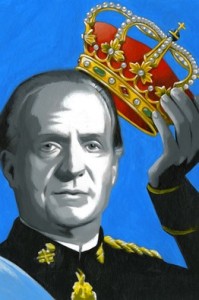WSJ Historically Speaking: When a Monarch Calls It Quits
Abdication fever is sweeping the royal palaces of Europe. Recently, Spain’s King Juan Carlos became the third monarch in just over a year to renounce his crown. In January 2013, Queen Beatrix of the Netherlands declared that she was stepping down in favor of her son, Prince Willem-Alexander. King Albert II of Belgium followed six months later.
Abdication in the old days was usually a prelude to execution. Lucius Tarquinius Superbus, or Tarquin the Proud (who ruled from 534 to 509 B.C.), is one of the earliest recorded examples of a monarch who was forced to abdicate and still lived to tell the tale. Tarquin was the seventh and last king of the Romans. Burdened by heavy taxes, the aristocracy was already wishing to be rid of Tarquin when his son raped the pious Lucretia. The crime proved to be the catalyst for the birth of the Roman republic.
Tarquin eventually retired to the court of a neighboring tyrant. There, bored and angry, he plotted endlessly to reconquer Rome. Today, if Tarquin is remembered at all, it is by the generations of British schoolchildren who grew up learning to recite “Horatius at the Bridge,” Thomas Babington Macaulay’s stirring ballad on Tarquin’s defeat: “Lars Porsena of Clusium, / by the Nine Gods he swore, / That the great house of Tarquin / Should suffer wrong no more…And how can man die better/ Than facing fearful odds / For the ashes of his fathers / And the temples of his gods.”
One of the few monarchs in history to abdicate voluntarily was Queen Christina of Sweden (1626-89). Some historians now speculate that her rebellious behavior may have been caused by Asperger syndrome, a mild form of autism. Christina was certainly eccentric. She retired at age 28 and went to live in Rome, where she turned her palazzo into an amateur theater. Despite having hated royal life when she had it, Christina came to regret her decision to abdicate and tried over the years to become the queen of Naples, Poland and even Sweden again—to no avail. She died in Rome as plain Maria Christina Alexandra.
Still, things weren’t all bad. With no courtiers to placate, Christina could spend as she pleased, an example followed by other ex-monarchs—notably King Farouk of Egypt, who was forced to abdicate in 1952 by the Free Officers led by Gamal Abdel Nasser. Farouk had to depart so quickly that he left behind his beloved collection of pornographic neckties. But he recovered his equanimity enough to become a regular on the Monte Carlo nightclub scene. Farouk lived off a diet of oysters, cabarets and showgirls until he died suddenly of a heart attack in Rome in 1965 while entertaining a mysterious blonde.
Compared with King Farouk, the duke of Windsor (formerly King Edward VIII) lived a life of peerless rectitude after giving up the British throne in 1936 to marry his belovedWallis Simpson. He whiled away World War II as the governor of the Bahamas and then retired to Paris, where Wallis could indulge her passion for being both rich and thin. The duke and duchess became social curiosities—ostracized at home but celebrity fixtures in cafe society.
The crisis in the British monarchy caused by Edward VIII’s abdication is said to be one of the chief reasons why Queen Elizabeth II is determined never to step down. At 88, she remains so popular that during the recent D-Day commemorations in France, her visit to Paris brought the city to a near standstill. The hapless King Farouk wasn’t known for his wit or prescience, but he did make one telling prediction: “There will soon be only five kings left: the kings of England, diamonds, hearts, spades and clubs.”

